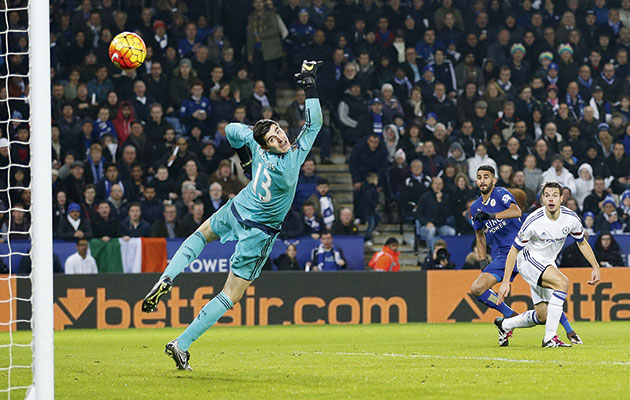Leicester City’s victory over Chelsea in December felt like a distillation of the Premier League season so far. It wasn’t just that Chelsea looked anxious and disjointed, or that Jamie Vardy and Riyad Mahrez, scored excellent goals; it was that, once again, the team with less possession were victorious.
It becoming an increasing trend. That weekend, the only sides in the Premier League to have more possession than their opponents and win were Arsenal and Watford. Perhaps not insignificantly, they were playing the bottom two sides in the division. Even Manchester City had less of the ball – although only just: 49.9 per cent to 50.1 per cent – in overcoming Swansea City. Liverpool, meanwhile, failed to beat West Bromwich Albion despite having 68 per cent possession.
The only game that followed what might be termed a traditional pattern of one side dominating and turning that control into chances and goals was Arsenal’s 2-0 victory at a dismal Aston Villa.
That goes hand in hand with another trend in the Premier League this season. After every side had played 16 games, 37.5 per cent of matches had finished in home wins and 33.75 per cent in away wins, against an average over the past decade of 46.9 per cent home wins and 28.1 per cent away wins. It’s true that the pattern was more pronounced earlier in the season, and home wins have made a surge of late but as the Premier League approached its halfway point that’s a striking shift. Home advantage, it would seem, is less significant than it once was.
The reasons that home advantage has become less important is readily explicable, as travel is easier and quicker now than it was a century ago, teams can afford to stay in the best hotels, sports science has advanced to improve preparation, and stadiums and pitches are far more homogenised than they were, with conditions far more standardised.
This season, however, the change, would appear to be related to tactics.
This is an age in which dominating possession is not merely not a guarantee of victory, but seems to make winning harder.
More and more teams are counter-attacking successfully and, given that it’s customary for the home side to look to take the initiative, that perhaps explains why fewer home teams are winning.
The Premier League this season is packed with good counter-attacking teams: Leicester, Crystal Palace and West Ham United have all achieved notable results away from home. Watford essentially beat the sides below them and lose to the sides above them, but they too are a team that plays on the counter, as are West Brom, inconsistent as they have been.
Yet there is a paradox here. For all the pundits’ talk about the importance of transitions, and for all that anybody watching Leicester this season must have had the sense of a side that sits deep and springs forward thrillingly, according to Opta, only 4.7 per cent of Premier League goals so far this season have come from counters – Leicester, with four, have scored the most. While that is up on the 3.8 per cent of last season, it’s down on the 5.4 per cent of the previous campaign.
Opta’s definition of what constitutes a goal scored on the counter is very strict, so it’s important when making comparisons to do so within the same data provider.
UEFA’s figures for what’s happening in the Champions League, though, are telling.
There is a section in the report on last season’s competition headed “Counters are key” in which the former Werder Bremen coach Thomas Schaaf makes the point that Barcelona – who under Pep Guardiola were the kings of the beautiful attrition of possession – have added counters to their game thanks to the pace of their forward line and the willingness of Ivan Rakitic to play risky forward passes.

The pace of Luis Suarez, Neymar and Lionel Messi, means the counter-attack has been added to Barcelona’s already formidable attacking armoury.
But it also notes that 20.6 per cent of goals from open play were scored from counters, down from 23 per cent in 2013-14 and 27 per cent the season before that. It is also worth noting, with the caveat that the definition of a counter may be a little different, that a report in 2005-06 by UEFA technical director Andy Roxburgh suggested as many as 40 per cent of all goals from open play came from counter-attacks. In other words, what we’re seeing is that, despite the perception that more teams are getting better at countering, the proportion of goals scored on the counter is dropping.
It must be acknowledged that the Champions League is not the Premier League and that in Europe’s premier club competition the better teams are better and the worse teams are worse.
It’s also apparent that the teams whose counter-attacking has been most eye-
catching this season are those from what might be termed the Premier League’s middle-class who, partly because of their own performances and partly because of under-performance from the elite, have imposed themselves to a greater extent than usual.
But the incompatibility of the statistics and the perception probably lies in the difficulty of defining a counter, particularly given the rise of gegenpressing. A key part of the style of both Guardiola and Jurgen Klopp is to try to win the ball back immediately after it is lost, thus stifling a counter from the opposition while potentially initiating one of their own. Is a counter-counter still a counter? And what if the counter-counter is countered?
There’s a further logical difficulty with the rise of countering and counter-countering, which is what happens when two teams whose game is based on countering meet. If neither particularly wants the ball, the game becomes a game of chicken, with each side urging the other to make the first move.
After the era of radical possession, it feels that football has moved into a new age, one on which not having the ball has become preferable to having it.
By Jonathan Wilson







